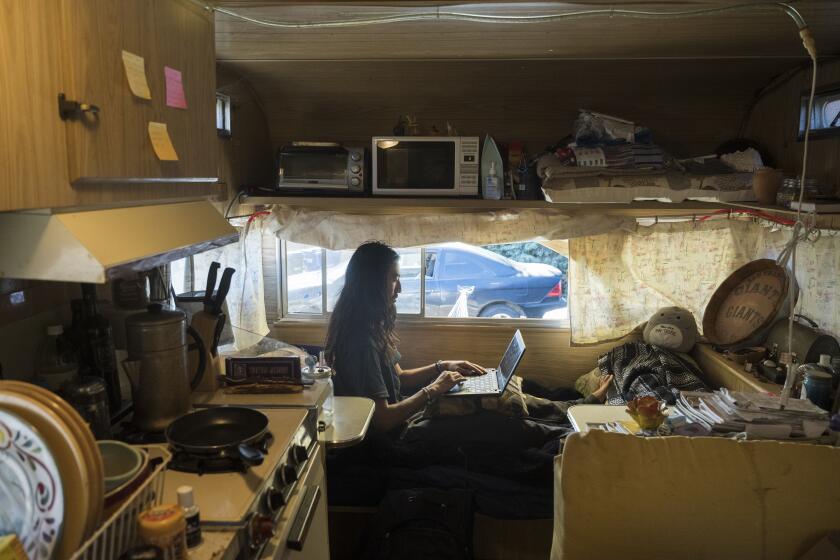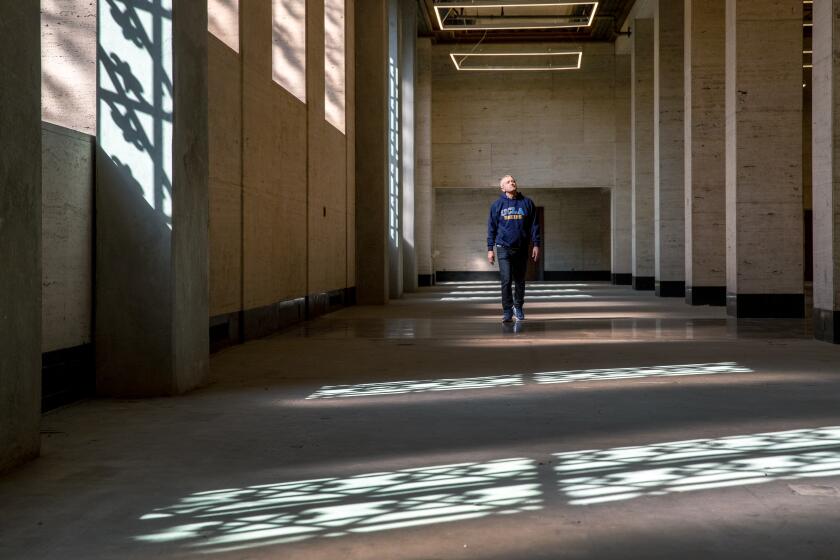How small is too small? UC Regents delay approval of new UCLA dorm, questioning room size

UCLA has been planning the best deal in town for student housing: a new residence hall featuring shared living, study and socializing spaces with most rooms going for just $600 a month — 66% below projected market rates in the pricey Westwood neighborhood where the campus is located.
But the eight-story, 545-bed project hit a roadblock Thursday, when the University of California Regents deferred a vote on its budget and design after raising crucial questions about whether the rooms were too small and what potential impact that might have on student mental health. The planned space is 265 square feet for three beds, desks, closets, storage space and a refrigerator.
“I don’t want to call these jails,” Regent Hadi Makarechian said during finance committee discussions Wednesday, “but ... these aren’t really good dorms.”
Regent John A. Pérez noted that research has found that “micro-units” have been linked to negative mental health effects. When a UCLA official said he was trying to keep costs down for low-income students, Pérez took umbrage at the implication that “for poor kids, this density is OK.” This prompted an apology from the official, Pete Angelis, UCLA assistant vice chancellor of housing and hospitality.
Lt. Gov. Eleni Kounalakis, an ex-officio regent, lamented the trend of “smaller and smaller” spaces as campuses cram more students into rooms to address the affordable housing crisis.
“It really is worrisome,” she said. “What it comes down to is your efforts to use every square foot of land to produce space for as many students as possible. But there is a limit that can get us to the point where students can ... really experience negative mental health impact by the way that they’re being asked to live.”
As most University of California campuses start classes this month, the acute shortage of affordable housing is pushing many students into desperation, including living in trailers or working multiple jobs to cover high rents.
The regents asked UCLA to come back with more information comparing the project’s room size and cost per bed to others across the UC system, along with student feedback on their living spaces. They will reconsider the project in November.
The debate underscored the myriad and at times conflicting pressures over how to solve what many consider the top campus issue across California — the lack of affordable housing for students, staff and faculty. Piling more students into smaller spaces brings down the cost, but how small is too small?
At UC Santa Barbara, a shortfall in housing a few years ago prompted the campus to house some students in hotels, while other students have been forced to couch-surf or live in vehicles and tents. Yet an effort to build a mega-dorm to house 3,500 students — dubbed “Dormzilla” — drew widespread criticism.
Although the design featured large communal dining and study spaces, the single bedrooms were small without windows. That project has been paused, and the campus has called for proposals for alternative housing projects on the planned space. Meanwhile, Santa Barbara County supervisors sued UC Santa Barbara, claiming the campus has failed to address the impact of its growing student population on the community’s acute housing needs.
UCLA, by contrast, has been seen as a leader in providing campus housing. It was the first of the nine UC undergraduate campuses to offer a four-year housing guarantee for students, a milestone reached last year, after building nearly 6,000 new beds in the last three years with a $1.1-billion investment.
UCLA hasn’t drawn the fierce community opposition and lawsuits that have impeded housing projects on other campuses. And the campus received one of the coveted state grants for student housing, receiving $35 million for Gayley Towers, the dorm project before the regents at their UCLA meetings this week.
UCLA announced plans to expand in downtown Los Angeles with the purchase of the historic Trust Building for satellite classes, a move to widen access at the nation’s most popular university and help revitalize the city’s historic core.
UCLA is proposing to demolish the existing Gayley apartments, a six-story structure built in 1981 that includes 51 studio and studio loft units housing 100 students. The new residence hall would include community bathrooms and shared spaces for students to cook, eat, study and socialize in what housing officials said was an emerging “co-living” style of campus housing.
At least 350 of the 545 beds would be reserved for low-income students for a $600 monthly housing fee. Demolition was set to begin in June 2024, with construction scheduled for September 2024 and move-in in September 2026, UCLA officials said.
UC President Michael V. Drake had recommended approval — but the regents decided otherwise for now.
Regent Janet Reilly wanted to know how big the new building would be given that the plan was more than quadrupling the number of beds. Pérez asked whether UCLA had considered research finding that small units had a negative impact on mental health despite the positive attributes of co-living spaces, a question that campus officials did not address. And he and other regents raised other questions. Why didn’t UCLA build a higher structure to lessen the density of each unit? Is there the option of converting the triple-occupancy units to doubles?
Michael Beck, UCLA administrative vice chancellor, said triple-occupancy units drew the highest satisfaction among students.
A student survey administered between November 2022 and January 2023 showed no significant differences in satisfaction between the experiences in two- and three-bed units. The proposed Gayley Towers rooms would be comparable in size to the triple-occupancy rooms of 250 square feet in the newest campus complex, Olympic and Centennial Halls, which opened in fall 2021 and are fully occupied, UCLA said after the regents meeting Thursday.
Pérez said that UCLA might well have settled on the “sweet spot” between affordability and room size — but that he needed more information to make that decision.
More to Read
Sign up for Essential California
The most important California stories and recommendations in your inbox every morning.
You may occasionally receive promotional content from the Los Angeles Times.













